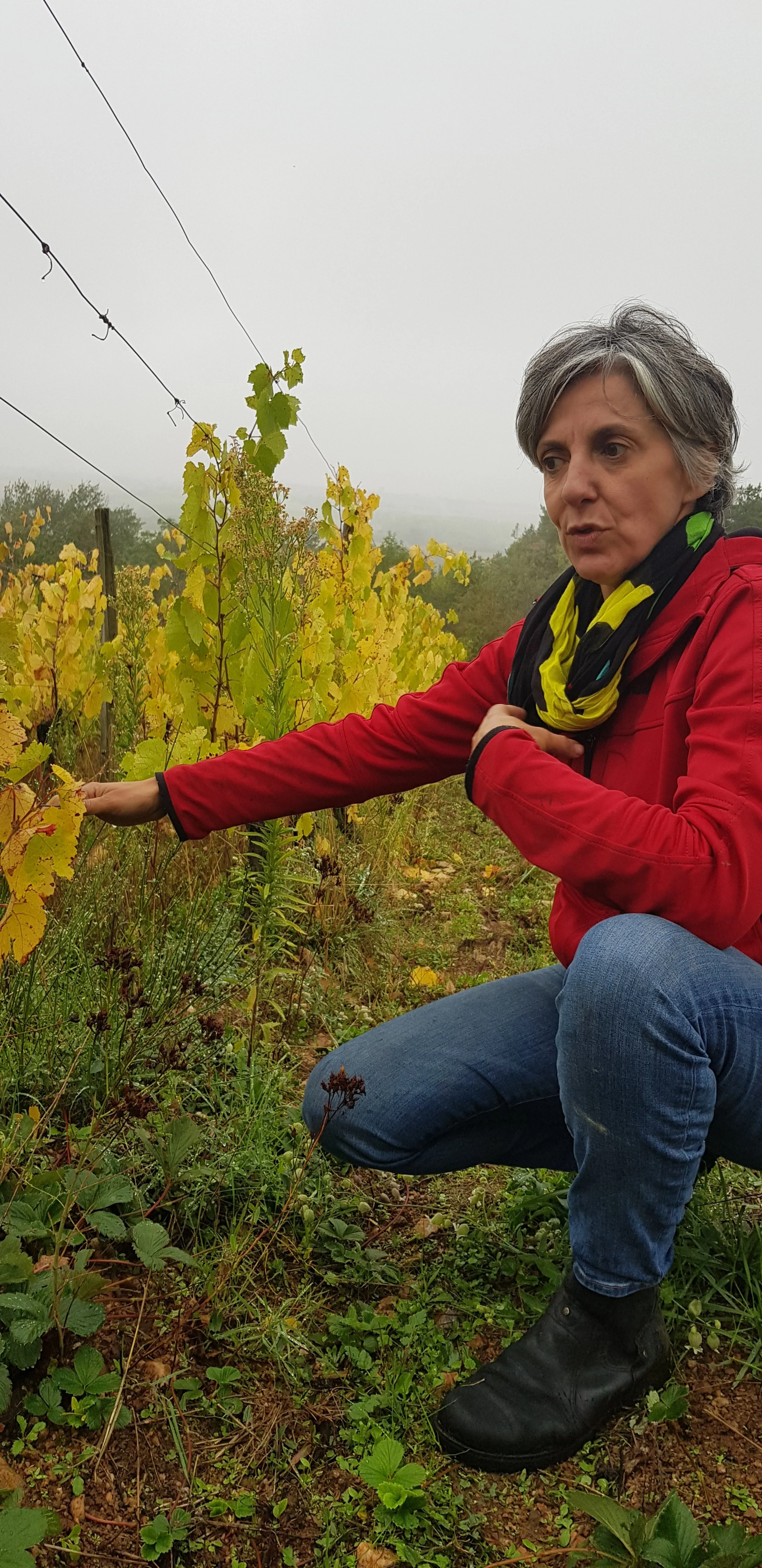L’egrappille / Catherine Dumora
Catherine Dumora farms a single, dramatic site high in the hills above Lamontgie, about 30 minutes south of Clermont-Ferrand in the Auvergne.
Catherine's history involves time spent living in Brazil and her former studies and work developed within her a very strong sense of social justice and appreciation for matriarchal societies. Formerly based in the village of Blanzat, Catherine Dumora and former partner Manu Duveau made wines together under the wonderful Yahou Fatal label, but disbanded in 2018.
Today, she is the most maternal farmer we know, her approach to vine management focussed almost exclusively on health and well-being with the meagre yields from this old vineyard being a happy result. With an emphasis on developing natural resistance, for the last couple of years Catherine has been working towards zero treatments in the vineyard with the only vineyard applications otherwise being biodynamic preps eau florale and sparing amounts of sulfur. In the 2020 growing season, Catherine did a single sulfur spray and then intermittently used a hydrosol of bay, garlic and thyme and a homeopathic application of tea trea oil (a truly homeopathic quantity of just 5ml per hectare).
Catherine's 1.5 hectares of old gamay d’Auvergne sits on a west facing slope of regionally unique terroir, the typical basalt of the region here giving way to granite, schist and quartz with deposits too of calcareous matter.
In addition to vinifying her own grapes, Catherine begun making a couple of negocée cuvees in 2021 using fruit from Minervois.
Having begun to remove wood from the elevage regime when still with Manu, today all of Catherine's wines are raised in fibreglass and sandstone and the sheer purity of fruit is undeniable.
A single mother of two young boys, Catherine's level of emotion and commitment to her vineyard is nothing short of inspirational.
Auvergne, France
Information on previous wines
-
Direct press chardonnay and pinot noir grown on a blend of schint, quartz and calcareous deposits, near Bansat. Elevage in sandstone jars
2020 A great year, giving fresh wines with excellent concentration. Round and mineral, with a faint impression of sugar.
2019 From a warmer, slightly richer year.
-
Gamay d’Auvergne grown on a blend of schist, quartz and calcareous deposits, near Blansat
2021 From a challenging and low-yielding year, this was the only cuvee Catherine was able to produce from her own vines in 2021. Resting.
2020 A cooler vintage than the previous year. Drier, with more precise and restrained fruit and more pronounced minerality.
2019 From a warmer year. Just off-dry with a small amount of dissolved CO2. Varietal red, slightly forestal fruit with well-balanced acidity, and the faint impression of sugar providing depth and concentration and a faithful reflection of the warm vintage.
-
Syrah, alicante bouschet and gamay d’Auvergne grown on a mix of granite, schist, quartz and basalt above the village of Bansat
2020 Mostly a direct press of gamay, to which destemmed berries of the syrah and alicante were added for a week of infusion, before being pressed off to sandstone jars for nine months of rest.
2019 Aromatic with earth and fruit. Medium-bodied, silken, deep and long on the palate, with light but rich fruit typical of the Auvergne.
-
Old-vine gamay d’Auvergne grown on a blend of quartz, schist and calcareous deposits, vinified in sandstone
2021 Resting
2020 In this year, Catherine decided to vinify her old vine gamay d’Auvergne with a very light touch – only about ¼ of the fruit was retained as whole berries, the remainder direct-pressed. The result is an energetic, bright and light red, best served at around 10-11C.
2019 From a warmer, slightly richer year.
-
Old-vine gamay d’Auvergne from Bansat, grown on a mix of schist, quartz, basalt and calcereous deposits
2020 Raised in sandstone. A cooler vintage than the previous year. Finer, more delicately structured, with precise fruit and great tension. Despite the elegance and delicacy of the cooler vintage, there still exists the tell-tale varietal richness of gamay d'auvergne on the palate, making this a good wine to serve at around 11-12C.
2019 Fermented and raised in tank. From a warmer year, resulting in a deep, rich and concentrated wine. Medium bodied, aromatic, silken and complex.
-
2021 Made from negoce sauvignon blanc from Minervois during a year in which Catherine lost a lot of her domaine fruit. Grown on a blend of clay, sand and silt that gives a different structure to the wine – more tightly woven and sinewy than the deep and generous wines grown by Catherine in the Auvergne, with a more restrained and earthen expression of fruit. A medium bodied palate here with supple texture, minerality, concentrated acidity and subtle influence from lees contact.
-
2021 -Made from negoce syrah and gamay from Minervois during a year in which Catherine lost a lot of her domaine fruit. Grown on a blend of clay, sand and silt that gives a different structure to the wine – more tightly woven and sinewy than the deep and generous wines grown by Catherine in the Auvergne, with a more restrained and earthen expression of fruit. Dark, more inky and serious fruit than black olive and game, with intense freshness. Very pure, this has a core of direct acidity that gives the palate drive and nerve.

